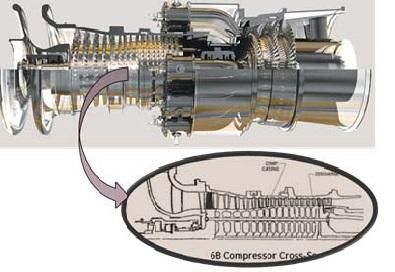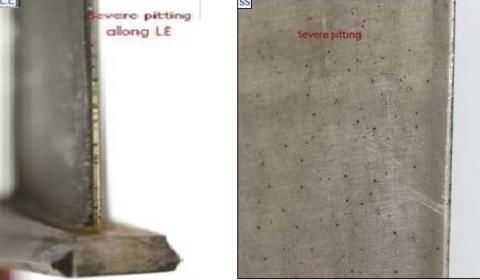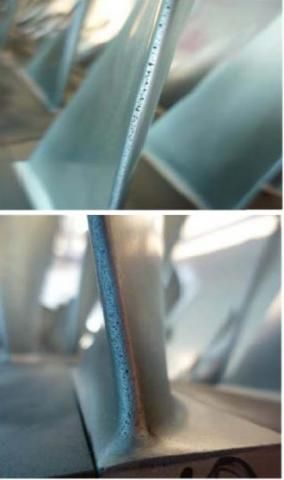Analysis of pitting corrosion on compressor blades
Below are excerpts from a case study presented by Khalid Latif and Kunal Ghosh at the Middle Eastern Turbomachinery Symposium 2015. Both are currently working as Sr. Rotating Engineers in Qatargas.

Qatargas is one of the world’s largest LNG producing companies with QG1 : 3 trains (3.3 MTPA),
QG2 : 2 trains (7.8 MTPA) and QG3/4 : 2 trains (7.8 MTPA). QG1 facilities operate six Fr6B gas turbines to drive power generators for meeting the electric power demand. HGPI and MI of Fr6B turbines operate every 32K & 64K hours respectively.
A comprehensive inspection campaign was carried out to investigate the severity of corrosion pitting, FOD, missing material, rubbing, crack and erosion.
Failure analysis – inspection methodology
To investigate the severity of the issue, both rotating and stationary blades were inspected using Visual Testing (VT) to measure external dimensions of the indication that opens up to the surface and Eddy Current Testing (ET) to estimate the volume of the indication referring to sample defects in the form of flat bottom holes (FBH). It was observed that VT and ET complement each other for data collection purposes.

For the visual inspection of Filter House for both dirty and clean sections, the inspection plan was as follows:
The compressor blade was divided into different areas and locations, and
Customized ET probes were used for each location.
Pitting corrosion was observed on the first four rows of Rotating and Stationary blades.
In Leading Edge, it was from root to tip in multiple and cluster formations, volumetric dimensions of the pits estimated between 0.25x0.25mm and 0.5x0.5mm (FBH reference), external dimensions of the pits up to 1.5mm, and liquid erosion was detected. In the Airfoil, corrosion pitting was affecting areas 2 and 5 in multiple and cluster types with the estimated volume between 0.25x0.25mm and 0.5x0.5mm. The Fillet had randomly distributed smaller pits with estimated volume of 0.25x0.25mm.
At dirty section, heavy deposits of sand and moisture were covering almost 100 percent of the filter surfaces. There is a high likelihood that dirty air was regularly ingested by the turbine. There were signs of oxidation and general bad condition of fixtures observed at the clean section too. The self cleaning pulse jet system was not functioning properly.

Analysis of corrosion products on blades
Corrosion products in the pits were analyzed for both rotating and stationary blades. Apart from base material elements, the presence of Chlorine (Cl) and Sulfur (S) was found. The presence of Chlorine and
Sulfur (especially Cl) is the cause of pitting corrosion. Traces of Potassium, Sodium and Calcium were detected.
Facts
All the examined blades showed eroded coating along LE and severe pitting corrosion damage along LE and across the whole airfoil. The severity of damage was more than acceptable tolerances and limits set by the vendor for reliable turbine operation. Continued operation of the gas turbine with defective or damaged blades may result in airfoil liberation and resultant downstream compressor damage.
Conclusion
Pitting Corrosion observed on rotating/stationary blades was the result of presence of corrosive elements
(mainly Chlorine and Sulfur) in aqueous environment. The origin of Chlorine and Sulfur is from the turbine working environment, as confirmed by the analysis of powder from the filter cartridge. Low efficiency of filters and incorrect maintenance strategies are the most probable causes of contamination found on axial compressor blades. A contributor to severe pitting corrosion of axial compressor blades can be the lack of optimal water wash strategy.
Remedial actions
It was recommended that modified filter cartridges (F7 to H12) be used to improve filtration efficiency and prevent ingress of corrosive elements and moisture particles into axial compressor section (H12 filter cartridges are on order), and refurbish self‐cleaning pulse jet system according to original design. The scope of refurbishment included:
• Replacement of defective solenoid valves
• Adjustment of sequential timing of pulsing cycle
• Adjustment of pulse air pressure
• Adjustment of pulse air stroke cycle
It is necessary to check/rectify filter houses for possible air leakages, and also ensure correct installation of filter cartridges and that there is no damage of flexible transition pieces.
It is also essential to review the water wash strategy which is currently under development (Earlier water wash was performed on need basis in case of performance deterioration). It is important that operating philosophy is improved by minimizing standby duration of each Fr6B turbine to reduce the possibility of corrosion attack on machine internals. Furthermore, water wash and accurate dry out of the turbine is ensured before putting it on standby.
(Khalid Latif is a Graduate Mechanical Engineer with 20+ years experience in the field of maintenance / engineering of rotating equipment. He is currently working in Qatargas as Sr. Rotating Engineer.
Kunal Ghosh is a Graduate Mechanical Engineer with 18 years of experience in the field of construction, start-up and maintenance of rotating equipment of Power plant and Oil & Gas industries. He is currently working in Qatargas as Sr. Rotating Engineer.)